Connect With Us
Blog
Items filtered by date: January 2024
Common Symptoms of Bunions
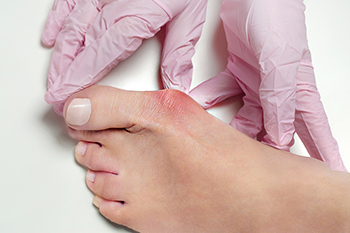
Bunions, a prevalent foot deformity, reveal themselves through an array of recognizable symptoms. One telltale sign is the development of a bony bump at the base of the big toe, often accompanied by redness and swelling. As the tip of the big toe deviates toward the adjacent toes, persistent pain or soreness ensues, particularly when walking or wearing shoes. Corns or calluses may form where the first and second toes overlap, exacerbating discomfort. Limited toe movement and stiffness can impede flexibility. Shoes that once fit comfortably may now cause tightness and discomfort, reflecting the altered shape of the foot. Recognizing these common symptoms is pivotal for timely intervention. By understanding these subtle yet critical signs, individuals can take proactive steps towards managing bunions and nurturing overall foot health. If you have developed a bunion, it is strongly suggested that you are under the care of a podiatrist who can determine what the best relief and treatment is for you.
If you are suffering from bunions, contact Eugene Little, DPM of Foot and Ankle Centers of Ohio. Our doctor can provide the care you need to keep you pain-free and on your feet.
What Is a Bunion?
A bunion is formed of swollen tissue or an enlargement of boney growth, usually located at the base joint of the toe that connects to the foot. The swelling occurs due to the bones in the big toe shifting inward, which impacts the other toes of the foot. This causes the area around the base of the big toe to become inflamed and painful.
Why Do Bunions Form?
Genetics – Susceptibility to bunions are often hereditary
Stress on the feet – Poorly fitted and uncomfortable footwear that places stress on feet, such as heels, can worsen existing bunions
How Are Bunions Diagnosed?
Doctors often perform two tests – blood tests and x-rays – when trying to diagnose bunions, especially in the early stages of development. Blood tests help determine if the foot pain is being caused by something else, such as arthritis, while x-rays provide a clear picture of your bone structure to your doctor.
How Are Bunions Treated?
- Refrain from wearing heels or similar shoes that cause discomfort
- Select wider shoes that can provide more comfort and reduce pain
- Anti-inflammatory and pain management drugs
- Orthotics or foot inserts
- Surgery
If you have any questions, please feel free to contact our office located in Sidney, OH . We offer the newest diagnostic and treatment technologies for all your foot care needs.
Choosing Appropriate Footwear for Restaurant Workers
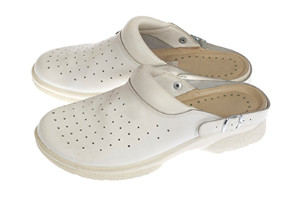
Selecting the right shoes for restaurant employees is paramount, considering the unique demands of the hospitality industry. Restaurant staff, who often spend long hours on their feet, require comfortable and supportive footwear to navigate the dynamic environment effectively. Slip-resistant shoes are essential, minimizing the risk of accidents in busy kitchens and dining areas. Opt for closed-toe styles to provide additional protection and prevent spills or sharp objects from causing harm. Comfort is key, so shoes with cushioning and arch support help alleviate the stress on the feet during extended shifts. Furthermore, choosing shoes made from breathable materials can enhance comfort and reduce the likelihood of foot-related issues. By investing in appropriate footwear, restaurant employees not only prioritize their foot health but also contribute to a safer and more efficient working environment. If you are working at a restaurant, it is suggested that you confer with a podiatrist who can provide you with specific information on the type of shoes to purchase.
While working on the feet, it is important to take the proper care of them. For more information about working on your feet, contact Eugene Little, DPM from Foot and Ankle Centers of Ohio. Our doctor will treat your foot and ankle needs.
Working on Your Feet
Standing on your feet for long periods of time can cause stress and pain in your feet. Your whole body may experience change in terms of posture, back pain, bunions, callouses and or plantar warts. There are ways to avoid these conditions with proper foot care, smart choices and correct posture.
Positive Changes
Negative heeled shoe – Choosing this shoe type places the heel slightly lower than the ball of the foot. These are great for overall foot health. Find shoes that fit you correctly.
Go barefoot – Our feet were not designed to be enclosed for all hours of the day. Try to periodically expose your feet to air.
Eliminate Pain
Foot Exercises – Performing simple exercises, incorporating yoga and doing stretches are beneficial. This will allow increased blood flow to the area and muscles of the foot.
Achilles tendon – Stretching the foot out flat on the floor will relax the calf muscles and tendon. These exercises can be performed almost anywhere. Make sure you add these exercises to your daily regimen.
With a little bit of this information and knowing more about foot health, you will notice changes. Foot stretches and proper footwear will help with pain and prevent further issues.
If you have any questions please feel free to contact our office located in Sidney, OH . We offer the newest diagnostic and treatment technologies for all your foot and ankle needs.
Identifying Symptoms of Poor Circulation in the Feet
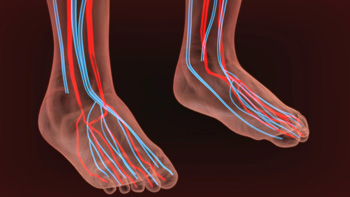
Poor circulation in the feet can manifest in various ways, serving as a silent signal of underlying health issues. One may notice a persistent tingling sensation or numbness, indicating compromised blood flow to the extremities. Swelling and discoloration, particularly a bluish or pale tint, are common signs as well. The skin might feel unusually cool to the touch, betraying a lack of proper blood circulation. Fatigue and weakness in the legs can also be attributed to reduced blood flow, impacting the muscles. Cramping and aching sensations may accompany these symptoms, often exacerbated during physical activity. Slow healing wounds and ulcers on the feet are red flags, as compromised circulation hampers the body's ability to repair itself. It is essential to pay attention to these subtleties, as they may signify an underlying vascular issue, emphasizing the importance of seeking timely medical evaluation from a podiatrist. If you have symptoms of poor circulation in your feet, it is suggested that you contact a podiatrist who can help you to manage this condition.
Poor circulation is a serious condition and needs immediate medical attention. If you have any concerns with poor circulation in your feet contact Eugene Little, DPM of Foot and Ankle Centers of Ohio. Our doctor will treat your foot and ankle needs.
Poor Circulation in the Feet
Poor blood circulation in the feet and legs is can be caused by peripheral artery disease (PAD), which is the result of a buildup of plaque in the arteries.
Plaque buildup or atherosclerosis results from excess calcium and cholesterol in the bloodstream. This can restrict the amount of blood which can flow through the arteries. Poor blood circulation in the feet and legs are sometimes caused by inflammation in the blood vessels, known as vasculitis.
Causes
Lack of oxygen and oxygen from poor blood circulation restricts muscle growth and development. It can also cause:
- Muscle pain, stiffness, or weakness
- Numbness or cramping in the legs
- Skin discoloration
- Slower nail & hair growth
- Erectile dysfunction
Those who have diabetes or smoke are at greatest risk for poor circulation, as are those who are over 50. If you have poor circulation in the feet and legs it may be caused by PAD and is important to make changes to your lifestyle in order to reduce risk of getting a heart attack or stroke. Exercise and maintaining a healthy lifestyle will dramatically improve conditions.
As always, see a podiatrist as he or she will assist in finding a regimen that suits you. A podiatrist can also prescribe you any needed medication.
If you have any questions please feel free to contact our office located in Sidney, OH . We offer the newest diagnostic and treatment technologies for all your foot and ankle needs.
Gout Pain Can Be Managed
How Diabetes Affects the Feet
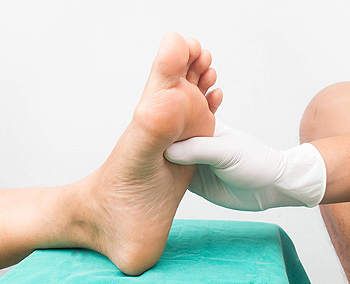
Living with diabetes involves a comprehensive approach to health, with a particular focus on the well-being of your feet. Diabetes affects the blood supply, resulting in peripheral neuropathy and peripheral vascular disease. Both conditions heighten the risk of complications, such as ulcers, gangrene, and possible loss of limb. Warning signs include cold feet, numbness, sharp leg pain, or changes in foot color. Nail changes, corns, calluses, cracked, or dry skin warrant a podiatrist's assessment within one week. The extremities, like the feet, often reveal the first signs of diabetes-related symptoms. Regular check-ups with a podiatrist are essential for tests to gauge blood circulation and nerve function. Prevention is key to averting severe diabetic-related foot problems. Daily care for diabetics includes maintaining stable blood sugar levels, refraining from smoking, engaging in regular exercise, and avoiding barefoot walking. Ensure good foot hygiene by washing and drying the feet daily, and checking the feet for sores, cuts, or unexplained bruises. Wearing well-fitting shoes is also beneficial. Should you notice persistent issues affecting the feet, it is strongly suggested that you schedule an immediate appointment with a podiatrist.
Diabetic foot care is important in preventing foot ailments such as ulcers. If you are suffering from diabetes or have any other concerns about your feet, contact Eugene Little, DPM from Foot and Ankle Centers of Ohio. Our doctor can provide the care you need to keep you pain-free and on your feet.
Diabetic Foot Care
Diabetes affects millions of people every year. The condition can damage blood vessels in many parts of the body, especially the feet. Because of this, taking care of your feet is essential if you have diabetes, and having a podiatrist help monitor your foot health is highly recommended.
The Importance of Caring for Your Feet
- Routinely inspect your feet for bruises or sores.
- Wear socks that fit your feet comfortably.
- Wear comfortable shoes that provide adequate support.
Patients with diabetes should have their doctor monitor their blood levels, as blood sugar levels play such a huge role in diabetic care. Monitoring these levels on a regular basis is highly advised.
It is always best to inform your healthcare professional of any concerns you may have regarding your feet, especially for diabetic patients. Early treatment and routine foot examinations are keys to maintaining proper health, especially because severe complications can arise if proper treatment is not applied.
If you have any questions please feel free to contact our office located in Sidney, OH . We offer the newest diagnostic and treatment technologies for all your foot and ankle needs.
The Discomfort of Morton’s Neuroma
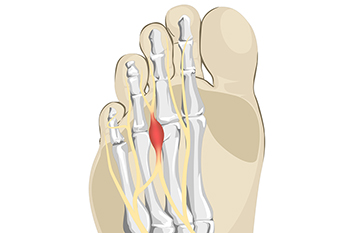
Morton's neuroma, a nerve disorder affecting the feet, emerges as a reality for many individuals seeking to understand the source of their discomfort. This condition is characterized by the thickening of tissues surrounding the nerves leading to the toes. It is not an actual tumor, as the name might suggest, but a response to nerve irritation and compression. Often occurring between the third and fourth toes, Morton's neuroma triggers a variety of symptoms, including sharp pain, burning sensations, and the feeling of having a pebble in the shoe. The causes of Morton's neuroma are multifaceted. Anything that exert constant pressure on the forefoot, such as wearing high-heeled shoes or engaging in certain activities, such as running, may contribute to the development of this condition. If you are experiencing any of the above symptoms, it is strongly suggested that you schedule an appointment with a podiatrist who can accurately diagnose and treat Morton’s neuroma.
Morton’s neuroma is a very uncomfortable condition to live with. If you think you have Morton’s neuroma, contact Eugene Little, DPM of Foot and Ankle Centers of Ohio. Our doctor will attend to all of your foot care needs and answer any of your related questions.
Morton’s Neuroma
Morton's neuroma is a painful foot condition that commonly affects the areas between the second and third or third and fourth toe, although other areas of the foot are also susceptible. Morton’s neuroma is caused by an inflamed nerve in the foot that is being squeezed and aggravated by surrounding bones.
What Increases the Chances of Having Morton’s Neuroma?
- Ill-fitting high heels or shoes that add pressure to the toe or foot
- Jogging, running or any sport that involves constant impact to the foot
- Flat feet, bunions, and any other foot deformities
Morton’s neuroma is a very treatable condition. Orthotics and shoe inserts can often be used to alleviate the pain on the forefront of the feet. In more severe cases, corticosteroids can also be prescribed. In order to figure out the best treatment for your neuroma, it’s recommended to seek the care of a podiatrist who can diagnose your condition and provide different treatment options.
If you have any questions, please feel free to contact our office located in Sidney, OH . We offer the newest diagnostic and treatment technologies for all your foot care needs.

